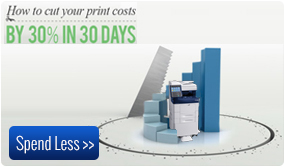By: John Morrison
John Morrison is Vice President of Marketing for Xerox Canada. He is responsible for the development and execution of marketing strategies for Xerox’s technology and document outsourcing services portfolio in Canada.
Has your organization started its paper-to-digital transformation yet? If you haven’t, you’re not alone. Many organizations have put this off because they just don’t know where to start. The whole idea of digital business is overwhelming – but urgent.
When processes are paper-based, employees can’t easily access information or share it across groups, especially when teams are distributed or mobile. Paper puts barriers between people and their work processes, and between different functions within the organization, resulting in dreaded “silos.”
More than 80 percent of small/mid-size businesses (SMBs) want to cut paper out of the way they invoice, report financials, manage legal and human resource forms, and handle other time consuming processes, according to a recent Xerox survey.
The survey of more than 1,000 international SMB companies shows respondents expect to make the change during the next 12 months. Nearly half (46 percent) of respondents confirmed that a significant amount of time is wasted on paper-intensive processes and 6 out of 10 view this as having a major impact on their bottom line.
So what’s the problem? Research continually confirms that one of the main roadblocks to digital transformation (DT) is deciding which processes to transform. The vast number of processes in a typical business makes the whole notion of becoming a digitally enabled organization unnerving.
That’s why Xerox Canada has created a new paper-to-digital workbook detailing a four-step approach to help organizations reduce paper in their processes.
Step 1 — Understand
Establish how and where you use paper today, and identify what you could change.
The distinction between “good” and “bad” paper helps identify where you really need to use paper, and where you could get rid of it.
“Good” paper refers to documents that have a valid reason to be in hard-copy form, such as documents that originate on paper, like customers’ handwritten letters or documents that require a “wet ink” signature.
“Bad” paper refers to documents that are in paper format, but without any compelling reason to be so. These could include documents that were printed from digital originals or documents that get shared, stored or transported using physical systems.
Step 2 — Educate
Set targets, make your case and change user behaviors.
Before you can make improvements, you need to decide what “good” looks like. That means determining policies, setting targets and defining metrics – at the organizational and team levels and for individuals, too.
Targets at the individual level can help people understand what they have to do to make change happen. However, it’s vital to respect the role of printing in people’s daily activities – balance is key in achieving your overall objectives. The last thing you want is to drive users to costly workarounds, such as printing at home or using offsite service providers.
The best way to encourage behavior change is to give people ownership and control. If they know the targets they’re working toward, and how to achieve them, you’re already halfway to success.
Step 3 — Execute
Replace key functions and processes with digital equivalents.
Execution will only succeed if everyone within the affected group is on board. Unless your change is very minor or localized in scope, this will be a big job – it’s important to take it seriously. As a first step, list the teams, managers and individuals who will be affected by the planned change, and determine how each one will be affected. How will their work change? What will they need to do differently from day to day?
Now, for each team or person, consider which benefits of change are most significant, or most directly relevant to their work. How can you express each benefit so they can easily understand and relate to it?
Some processes are simply too large or complicated to be changed quickly. If changing everything in one go would be risky, consider targeting just one stage of a process first. Then, once that stage has been transformed, move on to the others. It may be slower, but if it avoids the risk of business disruption or data loss, that’s probably a wait worth having.
Step 4 — Improve
Use data and information to take your transformation to the next level.
Once you’ve successfully switched some of your tasks and processes from paper to digital, you can explore the potential for more wide-ranging change projects to automate and simplify key business workflows.
Many ideas for further improvement can come from data on how paper and printing are being used within your organization. Managed Print Services (MPS) generate data that can show you how much you’re printing and the cost. User analytics go a level deeper, showing you who is printing what and when. That can open up opportunities to tighten up security, increase automation and spread printing best practices, or simply monitor print usage to make sure your previous changes are taking root.
Of the SMBs surveyed in Xerox’s recent study, 42 percent have an MPS contract, while 40 percent said they plan to put an MPS contract in place within the next year. Sixty-six percent spend more than $1,000 each month for printing activities, a significant cost of doing business. Companies with MPS contracts cited reduced costs, decreased paper consumption and improved tracking of print costs as top benefits.
MPS can act as a springboard to help your organization shed its reliance on paper. The chances of digital transformation success are greater when you engage MPS, because you can start with the day-to-day document processes that touch your device endpoints. This approach makes it easier to break digitization into bite-sized chunks and implement solutions based on data. A measured pace of change lets you transform at a manageable rate. And once you start, you’ll never go back.
You can download a copy of Xerox’s print-to-digital workbook at https://www.xerox.com/en-us/managed-print-services/insights/advantages
Source:: xerox news










